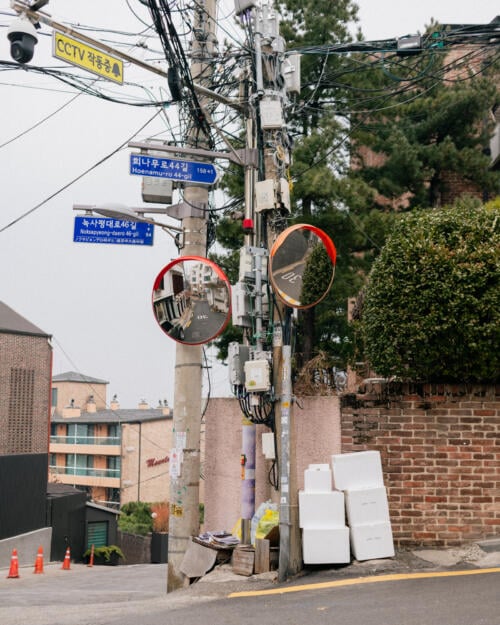
This jacket from Ferdinando Caraceni has become one of my real favourites in the past couple of years, and I think it’s worth exploring why. It says something about where tailoring is today, at least for me.
It was made in 2021 by Nicoletta Caraceni (who runs the small Milanese tailoring started by her father). I didn’t cover it at the time, as I used to only do review articles for new tailors. But as those have decreased (the recent spate of Korean commissions part) it makes more sense to look at subsequent commissions in the same detail.
Nicoletta has a wonderful selection of vintage cloth, mostly around dark suitings and summer cottons and linens. The previous DB jacket I had was in a vintage cotton, and this one was made in a vintage wool/cashmere. However, it wouldn’t be that hard to find something similar today – I’d guess it’s around 11oz and a 90/10 split between wool and cashmere.
The colour is very dark – real menswear navy. I wouldn’t call it midnight, but it is the kind of colour that a non-menswear person might call black, not picking up on the richness that could only come from navy. For a smart navy blazer, it’s perfect.
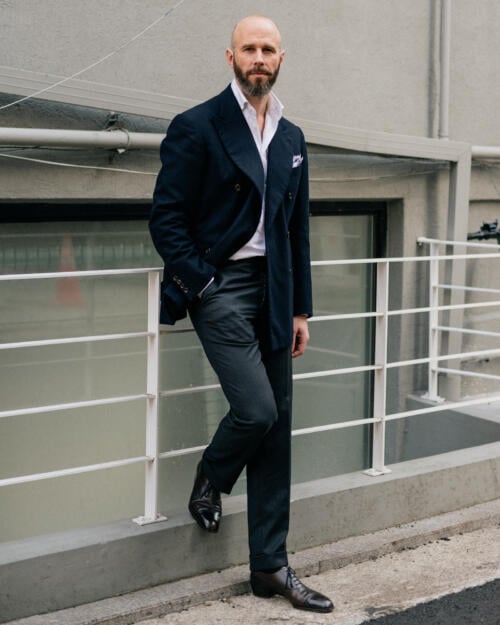
It is the cut, however, which is the most interesting.
Ferdinando Caraceni jackets have a fairly strong, wide shoulder. This is achieved not with a thick uniform pad (as Huntsman or Sexton might do) but with one that is more wedge-shaped – nothing at the neck and substantial at the end. You get the shape without the bulk.
This is accentuated by the lapel which I’d describe as generous in width and generously bellied, without either being extreme.
And this is the key I think to its style. The overall effect is rather striking, but without any element that stands out. Unlike cuts like Sexton or Chittleborough & Morgan in the UK, or the big shoulders of a Sciamat in Italy.
In fact, for me this might be the essence of the beauty of classic menswear – and combined with the beauty in details (fine buttonholes) and beauty in materials (cloth and buttons and lining) it gives me real, physical joy to wear.
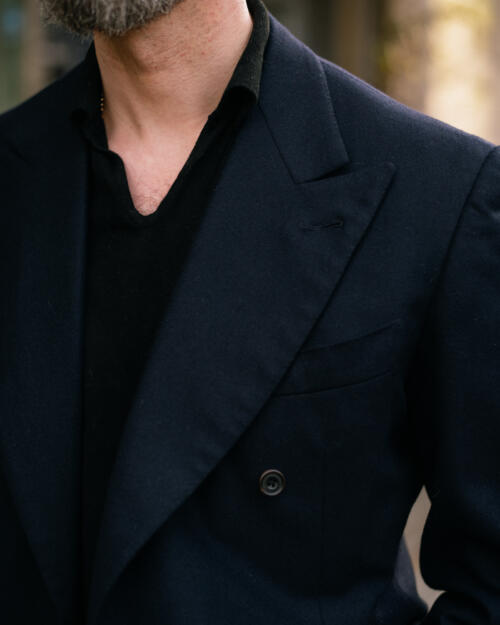
That said, it would not necessarily have been suitable in my previous life, working in a City office. In a world of very standard suits and ties, it would have stood out too much (no one would even be wearing a DB, let alone this DB).
And today, it’s not what I would recommend to most readers looking to commission bespoke for the first time. Because what that person usually wants is an everyday item, a replacement for the everyday suit, which fits well and has taste, but otherwise is very casual and relaxed.
For that reader, a soft-shouldered Neapolitan jacket is much more suitable, and that’s why they’ve become so popular in the past 20 years. It goes with jeans and chinos and flannels and worsteds simply and easily.
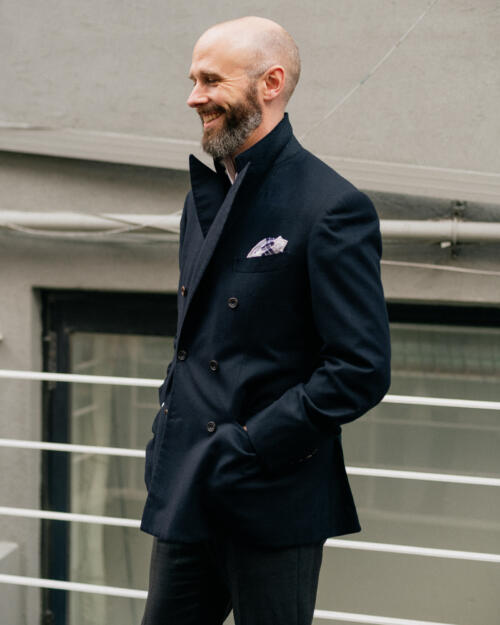
A double-breasted Caraceni jacket has slightly more to say for itself. We’re talking small margins, as ever, but it’s slightly bigger, slightly stronger.
The outfit above is the most classic thing I think you could wear it with – perhaps with the exception of the pocket square. Get rid of that, and it’s the most conservative combination of navy jacket, white shirt and grey trousers.
But the jacket still has something to say for itself. (Rather like the Yohei Fukua shoes – where it’s the bespoke waist and perhaps the delicate colouring that do the talking.)
The way I enjoy wearing it most today though, is with jeans and a polo shirt as below. Suddenly we’re playing with contrasts: a very smart material against the roughness of denim; a very sharp cut against the softness of the polo.
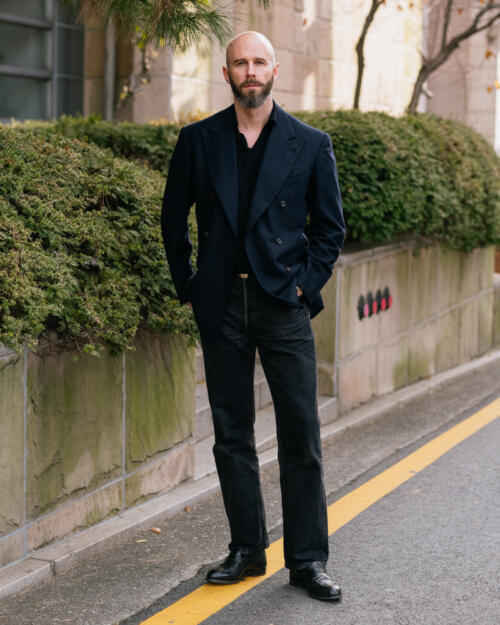
Readers often ask for clear answers, for rules, and I get that. When you’re learning it makes everything a lot easier and faster.
But the fun really comes with messing around with those rules and finding out how combinations can work in less easy ways.
Here, for example, the jeans wouldn’t work (as I’ve tried it) if they were indigo, or more heavily faded, or a less straight cut. The polo needs a collar that actually stands up underneath the jacket. I also wouldn’t normally tuck it in, but the punctuation of the belt buckle stops it all from being too plain.
There’s real style in these contrasts, I think, but it’s a more delicate thing to put together – a more complicated recipe (as Alois would put it).
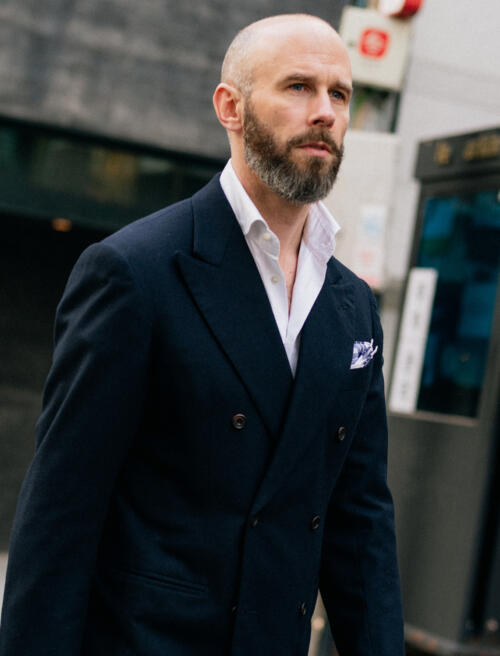
I like the look in the evening, as that suits the dark colours and the touch of drama. I know many others that say their bespoke commissions are often designed for dressing up these days – for events, usually in the evening – and this would fit well.
Of course, a more glamorous event would suit cocktail attire, which is itself a really enjoyable modern way to wearing tailoring. And a more casual evening might be best with a navy knit, the style coming more from the play of navy and black, and little accessories (brown suede boots, perhaps, and an interesting brown suede belt).
I can even see a theory of evening dress that divides outfits into those three types – cocktail attire, jacket/jeans and knitwear/jeans – but where they share ideas of materials, darkness and personality in the details.
One for another day. Today I hope you found interesting and useful my exploration of why I enjoy by Caraceni jacket so much – and two different ways I do.

The other items shown are: Rubato black polo shirt; Ludens black crocodile belt; vintage Levi’s black jeans; Edward Green black Piccadilly loafers; Yohei Fukuda oxfords; Simone Abbarchi white poplin shirt; Caliendo charcoal worsted trousers.
I am also in debt to Carl and Oliver at Rubato for their constant style inspiration. Carl himself wears something very similar.
